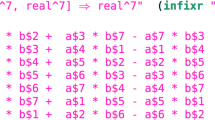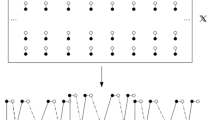Abstract
We present a formalization of several fundamental notions and results from Quantum Information theory in the proof assistant Isabelle/HOL, including density matrices and projective measurements, along with the proof that the local hidden-variable hypothesis advocated by Einstein to model quantum mechanics cannot hold. The proof of the latter result is based on the so-called CHSH inequality, and it is the violation of this inequality that was experimentally evidenced by Aspect, who earned the Nobel Prize in 2022 for his work. We also formalize various results related to the violation of the CHSH inequality, such as Tsirelson’s bound, which quantifies the amount to which this inequality can be violated in a quantum setting.


Similar content being viewed by others
Notes
Since then, it has been proven that this phenomenon is in no contradiction with the theory of relativity and does not imply faster-than-light communication.
The superscript is omitted when there is no confusion.
Lemma
 .
.As mentioned in [33], it would be more precise to write in a causally disconnected manner meaning that no information can be transmitted between Alice and Bob. This is ensured in practice by physically separating them, assuming that information cannot travel faster than light.
Including in the original paper on the CHSH inequality [15].
Note that these notions are formalized in a general setting that makes no mention of bipartite states or tensor products.
References
Aspect, A.: Experimental tests of Bell’s inequalities in atomic physics. In: Lindgren, I., Rosén, A., Svanberg, S. (eds.) Atomic Physics 8, pp. 103–128. Springer, Boston (1983)
Ballarin, C.: Locales: a module system for mathematical theories. J. Autom. Reason. 52(2), 123–153 (2014)
Bell, J.S.: On the Einstein Podolsky Rosen paradox. Physics 1(3), 195–200 (1964)
Berta, M., Brandão, F.G., Gour, G., Lami, L., Plenio, M.B., Regula, B., Tomamichel, M.: On a gap in the proof of the generalised quantum Stein’s lemma and its consequences for the reversibility of quantum resources. arXiv preprint arXiv:2205.02813 (2022)
Boender, J., Kammüller, F., Nagarajan, R.: Formalization of quantum protocols using Coq. Electron. Proc. Theoret. Comput. Sci. 195, 71–83 (2015)
Bordg, A., Lachnitt, H., He, Y.: Isabelle marries Dirac: a library for quantum computation and quantum information. Archive of Formal Proofs (2020). https://isa-afp.org/entries/Isabelle_Marries_Dirac.html, Formal proof development
Bordg, A., Lachnitt, H., He, Y.: Certified quantum computation in Isabelle/HOL. J. Autom. Reason. 65(5), 691–709 (2021)
Bordg, A., Paulson, L.C., Li, W.: Simple type theory is not too simple: Grothendieck’s schemes without dependent types. Exp. Math. 31(2), 364–382 (2022)
Brandao, F.G., Gour, G.: Reversible framework for quantum resource theories. Phys. Rev. Lett. 115(7), 070503 (2015)
Brandao, F.G., Plenio, M.B.: Entanglement theory and the second law of thermodynamics. Nat. Phys. 4(11), 873–877 (2008)
Brandao, F.G., Plenio, M.B.: A generalization of quantum Stein’s lemma. Commun. Math. Phys. 295, 791–828 (2010)
Brandao, F.G., Plenio, M.B.: A reversible theory of entanglement and its relation to the second law. Commun. Math. Phys. 295, 829–851 (2010)
Chareton, C., Bardin, S., Bobot, F., Perrelle, V., Valiron, B.: An automated deductive verification framework for circuit-building quantum programs. In: Yoshida, N. (ed.) Programming Languages and Systems—30th European Symposium on Programming, ESOP 2021, Held as Part of the European Joint Conferences on Theory and Practice of Software, ETAPS 2021, Luxembourg City, Luxembourg, March 27–April 1, 2021, Proceedings. Lecture Notes in Computer Science, vol. 12648, pp. 148–177. Springer, Luxembourg (2021)
Cirel’son, B.S.: Quantum generalizations of Bell’s inequality. Lett. Math. Phys. 4(2), 93–100 (1980)
Clauser, J.F., Horne, M.A., Shimony, A., Holt, R.A.: Proposed experiment to test local hidden-variable theories. Phys. Rev. Lett. 23(15), 880–884 (1969)
Dalton, B.J., Garraway, B.M., Reid, M.D.: Tests for Einstein-Podolsky-Rosen steering in two-mode systems of identical massive bosons. Phys. Rev. A 101, 012117 (2020)
Durrett, R.: Probability? Theory and Examples. The Wadsworth & Brooks/Cole Statistics/Probability Series. Wadsworth Inc. Duxbury Press, Belmont (1991)
Echenim, M., Mhalla, M., Mori, C.: The CHSH inequality: Tsirelson’s upper-bound and other results. Archive of Formal Proofs (2023). https://isa-afp.org/entries/TsirelsonBound.html, Formal proof development
Echenim, M.: Quantum projective measurements and the CHSH inequality. Archive of Formal Proofs (2021). https://isa-afp.org/entries/Projective_Measurements.html, Formal proof development
Echenim, M.: Simultaneous diagonalization of pairwise commuting Hermitian matrices. Archive of Formal Proofs (2022). https://isa-afp.org/entries/Commuting_Hermitian.html, Formal proof development
Einstein, A., Podolsky, B., Rosen, N.: Can quantum-mechanical description of physical reality be considered complete? Phys. Rev. 47(10), 777–780 (1935). https://doi.org/10.1103/PhysRev.47.777
Fuhrmann, P.A.: Linear systems and operators in Hilbert space. Proc. Edinb. Math. Soc. 26(1), 113–114 (1983). https://doi.org/10.1017/S0013091500028145
Gelfand, I.M., Naimark, M.A.: On the imbedding of normed rings into the ring of operators in Hilbert space. Matematiceskij sbornik 54(2), 197–217 (1943)
Hensen, B., Bernien, H., Dréau, A.E., Reiserer, A., Kalb, N., Blok, M.S., Ruitenberg, J., Vermeulen, R.F., Schouten, R.N., Abellán, C.: Loophole-free Bell inequality violation using electron spins separated by 1.3 kilometres. Nature 526(7575), 682–686 (2015)
Hölzl, J.: Construction and stochastic applications of measure spaces in higher-order logic. PhD thesis, Institut für Informatik, Technische Universität München (2012)
Ji, Z., Natarajan, A., Vidick, T., Wright, J., Yuen, H.: MIP*= RE. Commun. ACM 64(11), 131–138 (2021)
Kammüller, F.: Attack trees in Isabelle extended with probabilities for quantum cryptography. Comput. Secur. 87, 101572 (2019)
Kammüller, F., Wenzel, M., Paulson, L.C.: Locales: a sectioning concept for Isabelle. In: Bertot, Y., Dowek, G., Théry, L., Hirschowitz, A., Paulin, C. (eds.) Theorem Proving in Higher Order Logics, pp. 149–165. Springer, Berlin (1999)
Kuncar, O., Popescu, A.: From types to sets by local type definition in higher-order logic. J. Autom. Reason. 62(2), 237–260 (2019)
Liu, J., Zhan, B., Wang, S., Ying, S., Liu, T., Li, Y., Ying, M., Zhan, N.: Quantum Hoare logic. Archive of Formal Proofs (2019). https://isa-afp.org/entries/QHLProver.html, Formal proof development
Liu, J., Zhan, B., Wang, S., Ying, S., Liu, T., Li, Y., Ying, M., Zhan, N.: Formal verification of quantum algorithms using Quantum Hoare Logic. In: Dillig, I., Tasiran, S. (eds.) Computer Aided Verification, pp. 187–207. Springer, New York (2019)
Mermin, N.D.: Hidden variables and the two theorems of John Bell. Rev. Mod. Phys. 65, 803–815 (1993)
Nielsen, M.A., Chuang, I.L.: Quantum Computation and Quantum Information: 10th Anniversary Edition, 10th edn. Cambridge University Press, Cambridge (2011)
Nipkow, T., Klein, G.: Concrete Semantics: With Isabelle/HOL. Springer, New York (2014)
Rand, R., Paykin, J., Zdancewic, S.: Qwire practice: formal verification of quantum circuits in Coq. Electron. Proc. Theoret. Comput. Sci. 266, 119–132 (2018). https://doi.org/10.4204/EPTCS.266.8
Ruan, M.Q., Zeng, J.Y.: Complete sets of commuting observables of Greenberger-Horne-Zeilinger states. Phys. Rev. A 70, 052113 (2004). https://doi.org/10.1103/PhysRevA.70.052113
Scarani, V.: Bell Nonlocality. Oxford Graduate Texts. Oxford University Press, Oxford (2019)
Scherer, W.: Mathematics of Quantum Computing: An Introduction. Springer, Switzerland (2019). https://doi.org/10.1007/978-3-030-12358-1
Storz, S., Schär, J., Kulikov, A., Magnard, P., Kurpiers, P., Lütolf, J., Walter, T., Copetudo, A., Reuer, K., Akin, A.: Loophole-free Bell inequality violation with superconducting circuits. Nature 617, 265–270 (2023)
Thiemann, R., Yamada, A.: Formalizing Jordan normal forms in Isabelle/HOL. In: Avigad, J., Chlipala, A. (eds.) Proceedings of the 5th ACM SIGPLAN Conference on Certified Programs and Proofs, Saint Petersburg, FL, USA, January 20–22, 2016, pp. 88–99. ACM, USA (2016)
Thiemann, R., Yamada, A.: Matrices, Jordan normal forms, and spectral radius theory. Archive of Formal Proofs (2015). https://isa-afp.org/entries/Jordan_Normal_Form.html, Formal proof development
Unruh, D.: Quantum relational Hoare logic. Proc. ACM Programm. Lang. 3, 1–31 (2019). https://doi.org/10.1145/3290346
Vidick, T.: Three-player entangled XOR games are NP-hard to approximate. SIAM J. Comput. 45(3), 1007–1063 (2016)
Acknowledgements
This work benefited from the funding program “Plan France 2030” (ANR-22-PETQ-0007) of the French National Research Agency.
Author information
Authors and Affiliations
Contributions
ME and MM wrote the main manuscript text and they both reviewed the manuscript.
Corresponding authors
Ethics declarations
Competing interests
The authors declare no competing interests.
Additional information
Publisher's Note
Springer Nature remains neutral with regard to jurisdictional claims in published maps and institutional affiliations.
Rights and permissions
Springer Nature or its licensor (e.g. a society or other partner) holds exclusive rights to this article under a publishing agreement with the author(s) or other rightsholder(s); author self-archiving of the accepted manuscript version of this article is solely governed by the terms of such publishing agreement and applicable law.
About this article
Cite this article
Echenim, M., Mhalla, M. A Formalization of the CHSH Inequality and Tsirelson’s Upper-bound in Isabelle/HOL. J Autom Reasoning 68, 2 (2024). https://doi.org/10.1007/s10817-023-09689-9
Received:
Accepted:
Published:
DOI: https://doi.org/10.1007/s10817-023-09689-9





 .
.